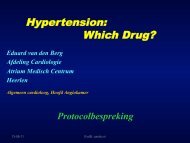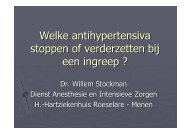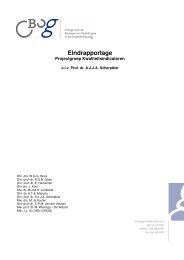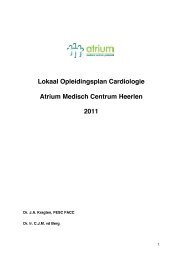12 ESC <str<strong>on</strong>g>Guidelines</str<strong>on</strong>g>images <strong>of</strong> regi<strong>on</strong>al tracer uptake that reflect relativeregi<strong>on</strong>al myocardial blood flow. With this technique, myocardialhypoperfusi<strong>on</strong> is characterized by reduced traceruptake during stress in comparis<strong>on</strong> with <strong>the</strong> uptake atrest. Increased uptake <strong>of</strong> myocardial perfusi<strong>on</strong> agent in<strong>the</strong> lung field identifies patients with severe and extensivecor<strong>on</strong>ary artery disease (CAD) 169–172 and stress-induced ventriculardysfuncti<strong>on</strong>. 173 SPECT perfusi<strong>on</strong> provides a moresensitive and specific predicti<strong>on</strong> <strong>of</strong> <strong>the</strong> presence <strong>of</strong> CADthan exercise ECG. Without correcti<strong>on</strong> for referral bias,<strong>the</strong> reported sensitivity <strong>of</strong> exercise scintigraphy has generallyranged from 70–98%, and specificity from 40–90%,with mean values in <strong>the</strong> range <strong>of</strong> 85–90% and 70–75%depending <strong>on</strong> <strong>the</strong> meta-analysis. 157,158,171,174Pharmacological stress testing with imaging techniques.Although <strong>the</strong> use <strong>of</strong> exercise imaging is preferable wherepossible, as it allows for more physiological reproducti<strong>on</strong> <strong>of</strong>ischaemia and assessment <strong>of</strong> symptoms, pharmacologicalstress may also be employed. Pharmacological stress testingwith ei<strong>the</strong>r perfusi<strong>on</strong> scintigraphy or echocardiography isindicated in patients who are unable to exercise adequatelyor may be used as an alternative to exercise stress. Twoapproaches may be used to achieve this: Ei<strong>the</strong>r (i) infusi<strong>on</strong><strong>of</strong> short-acting sympatho-mimetic drugs such as dobutamine,in an incremental dose protocol which increases myocardialoxygen c<strong>on</strong>sumpti<strong>on</strong> and mimics <strong>the</strong> effect <strong>of</strong> physical exercise;or (ii) infusi<strong>on</strong> <strong>of</strong> cor<strong>on</strong>ary vasodilators (e.g. adenosineand dipyridamole) which provide a c<strong>on</strong>trast between regi<strong>on</strong>ssupplied by n<strong>on</strong>-diseased cor<strong>on</strong>ary arteries where perfusi<strong>on</strong>increases, and regi<strong>on</strong>s supplied by haemodynamically significantstenotic cor<strong>on</strong>ary arteries where perfusi<strong>on</strong> will increaseless or even decrease (steal phenomen<strong>on</strong>).In general, pharmacological stress is safe and well toleratedby patients, with major cardiac complicati<strong>on</strong>s (includingsustained VT) occuring every 1500 tests with dipyridamole, or<strong>on</strong>e in every 300 with dobutamine. 156,175–177 Particular caremust be taken to ensure that patients receiving vasodilators(adenosine or dipyridamole) are not already receiving dipyridamolefor antiplatelet or o<strong>the</strong>r purposes, and that caffeineis avoided in <strong>the</strong> 12–24 h preceding <strong>the</strong> study, as it interfereswith <strong>the</strong>ir metabolism. Adenosine may precipitate br<strong>on</strong>chospasmin asthmatic individuals, but in such cases dobutaminemay be used as an alternative stressor. Dobutamine does notprovoke as great an increase in cor<strong>on</strong>ary blood flow asvasodilator stress, which is a limitati<strong>on</strong> for perfusi<strong>on</strong> scintigraphy.Thus, for this technique dobutamine is mostlyreserved for patients who cannot exercise and have ac<strong>on</strong>traindicati<strong>on</strong> to vasodilator stress. 178 The diagnosticperformance <strong>of</strong> pharmacological stress perfusi<strong>on</strong> andpharmacological stress echo are also similar to that <strong>of</strong> exerciseimaging techniques. Reported sensitivity and specificityfor dobutamine stress echo range from 40–100% and62–100%, respectively, and 56–92% and 87–100% for vasodilatorstress. 156,157 Sensitivity and specificity for <strong>the</strong> detecti<strong>on</strong><strong>of</strong> cor<strong>on</strong>ary disease with adenosine SPECT range from83–94% and 64–90%. 157On <strong>the</strong> whole stress echo and stress perfusi<strong>on</strong> scintigraphy,whe<strong>the</strong>r using exercise or pharmacological stress,have very similar applicati<strong>on</strong>s. The choice as to which isemployed depends largely <strong>on</strong> local facilities and expertise.Advantages <strong>of</strong> stress echocardiography over stress perfusi<strong>on</strong>scintigraphy include a higher specificity, <strong>the</strong> possibility <strong>of</strong> amore extensive evaluati<strong>on</strong> <strong>of</strong> <strong>the</strong> cardiac anatomy and functi<strong>on</strong>,and <strong>the</strong> greater availability and lower cost, in additi<strong>on</strong>to being free <strong>of</strong> radiati<strong>on</strong>. However, at least 5–10% <strong>of</strong>patients have an inadequate echo window, and specialtraining in additi<strong>on</strong> to standard echocardiographic trainingis required to correctly perform and interpret stress echocardiograms.Nuclear scintigraphy also requires specialtraining for performance and interpretati<strong>on</strong> <strong>of</strong> <strong>the</strong> tests.The development <strong>of</strong> quantitative echocardiographic techniquessuch as tissue Doppler imaging is a step towardsincreasing <strong>the</strong> inter-observer agreement and reliability <strong>of</strong>stress echo.N<strong>on</strong>-invasive diagnosis <strong>of</strong> CAD in patients with LBBB orwith permanent pacemaker in situ remains challenging forboth stress echocardiography and stress scintigraphic techniques,179,180 although stress perfusi<strong>on</strong> imaging is markedlyless specific in this setting. 181–184 Very poor accuracy isreported for both stress perfusi<strong>on</strong> and stress echocardiographyin patients with ventricular dysfuncti<strong>on</strong> associated withLBBB. 185 Stress echo has also been shown to have prognosticvalue even in <strong>the</strong> setting <strong>of</strong> LBBB. 186Although <strong>the</strong>re is evidence to support superiority <strong>of</strong> stressimaging techniques over exercise ECG in terms <strong>of</strong> diagnosticperformance, <strong>the</strong> costs <strong>of</strong> using a stress imaging test as firstline investigati<strong>on</strong> in all-comers are c<strong>on</strong>siderable. These arenot limited to <strong>the</strong> immediate financial costs <strong>of</strong> <strong>the</strong> individualtest, where some <strong>of</strong> <strong>the</strong> cost effectiveness analyses havebeen favourable in certain settings. 187,188 But o<strong>the</strong>r factorssuch as limited availability <strong>of</strong> testing facilities and expertise,with c<strong>on</strong>sequently increased waiting times for testing <strong>the</strong>majority <strong>of</strong> patients attending <strong>the</strong> evaluati<strong>on</strong> <strong>of</strong> anginamust also be c<strong>on</strong>sidered. The resource redistributi<strong>on</strong> andtraining implicati<strong>on</strong>s <strong>of</strong> ensuring adequate access for allpatients are c<strong>on</strong>siderable, and <strong>the</strong> benefits to be obtainedby a change from exercise ECG to stress imaging in allpatients are not sufficiently great to warrant recommendati<strong>on</strong><strong>of</strong> stress imaging as a universal first line investigati<strong>on</strong>.However, stress imaging has an important role to play inevaluating patients with a low pre-test probability <strong>of</strong>disease, particularly women, 189–192 when exercise testingis inc<strong>on</strong>clusive, in selecting lesi<strong>on</strong>s for revascularizati<strong>on</strong>,and in assessing ischaemia after revascularizati<strong>on</strong>. 193–196Pharmacologic stress imaging may also be used in <strong>the</strong> identificati<strong>on</strong><strong>of</strong> viable myocardium in selected patients with cor<strong>on</strong>arydisease and ventricular dysfuncti<strong>on</strong> in whom a decisi<strong>on</strong>for revascularizati<strong>on</strong> will be based <strong>on</strong> <strong>the</strong> presence <strong>of</strong> viablemyocardium. 197,198 A full descripti<strong>on</strong> <strong>of</strong> <strong>the</strong> methods <strong>of</strong>detecti<strong>on</strong> <strong>of</strong> viability is bey<strong>on</strong>d <strong>the</strong> scope <strong>of</strong> <strong>the</strong>se guidelinesbut a report <strong>on</strong> <strong>the</strong> imaging techniques for <strong>the</strong> detecti<strong>on</strong> <strong>of</strong>hibernating myocardium has been previously published byan ESC working group. 199 Finally, although stress imagingtechniques may allow for accurate evaluati<strong>on</strong> <strong>of</strong> changes in<strong>the</strong> localizati<strong>on</strong> and extent <strong>of</strong> ischaemia over time and inresp<strong>on</strong>se to treatment, periodic stress imaging in <strong>the</strong>absence <strong>of</strong> any change in clinical status is not recommendedas routine.Recommendati<strong>on</strong>s for <strong>the</strong> use <strong>of</strong> exercise stress withimaging techniques (ei<strong>the</strong>r echocardiography or perfusi<strong>on</strong>)in <strong>the</strong> initial diagnostic assessment <strong>of</strong> anginaClass I(1) Patients with resting ECG abnormalities, LBBB, .1 mmST-depressi<strong>on</strong>, paced rhythm, or WPW which prevent
ESC <str<strong>on</strong>g>Guidelines</str<strong>on</strong>g> 13accurate interpretati<strong>on</strong> <strong>of</strong> ECG changes during stress(level <strong>of</strong> evidence B)(2) Patients with a n<strong>on</strong>-c<strong>on</strong>clusive exercise ECG butreas<strong>on</strong>able exercise tolerance, who do not have ahigh probability <strong>of</strong> significant cor<strong>on</strong>ary disease andin whom <strong>the</strong> diagnosis is still in doubt (level <strong>of</strong>evidence B)Class IIa(1) Patients with prior revascularizati<strong>on</strong> (PCI or CABG) inwhom localizati<strong>on</strong> <strong>of</strong> ischaemia is important (level <strong>of</strong>evidence B)(2) As an alternative to exercise ECG in patients wherefacilities, cost, and pers<strong>on</strong>nel resources allow (level<strong>of</strong> evidence B)(3) As an alternative to exercise ECG in patients with a lowpre-test probability <strong>of</strong> disease such as women withatypical chest pain (level <strong>of</strong> evidence B)(4) To assess functi<strong>on</strong>al severity <strong>of</strong> intermediate lesi<strong>on</strong>s <strong>on</strong>cor<strong>on</strong>ary arteriography (level <strong>of</strong> evidence C)(5) To localize ischaemia when planning revascularizati<strong>on</strong>opti<strong>on</strong>s in patients who have already had arteriography(level <strong>of</strong> evidence B)Recommendati<strong>on</strong>s for <strong>the</strong> use <strong>of</strong> pharmacological stresswith imaging techniques (ei<strong>the</strong>r echocardiography orperfusi<strong>on</strong>) in <strong>the</strong> initial diagnostic assessment <strong>of</strong> anginaClass I, IIa, and IIb indicati<strong>on</strong>s as above if <strong>the</strong> patient isunable to exercise adequately.Stress cardiac magnetic res<strong>on</strong>ance. CMR stress testing inc<strong>on</strong>juncti<strong>on</strong> with a dobutamine infusi<strong>on</strong> can be used todetect wall moti<strong>on</strong> abnormalities induced by ischaemia.The technique has been shown to compare favourably todobutamine stress echocardiography (DSE) because <strong>of</strong>higher quality imaging. 200 Thus, dobutamine stress CMRhas been shown to be very effective in <strong>the</strong> diagnosis <strong>of</strong>CAD in patients who are unsuitable for dobutamine echocardiography.201 Studies <strong>of</strong> outcome following dobutamine CMRshow a low event rate when dobutamine CMR is normal. 202Myocardial perfusi<strong>on</strong> CMR now achieves comprehensiveventricular coverage using multislice imaging. Analysis isei<strong>the</strong>r visual to identify low signal areas <strong>of</strong> reduced perfusi<strong>on</strong>,or with computer assistance with quantificati<strong>on</strong> <strong>of</strong><strong>the</strong> upslope <strong>of</strong> myocardial signal increase during <strong>the</strong> firstpass. Although CMR perfusi<strong>on</strong> is still in development forclinical applicati<strong>on</strong>, <strong>the</strong> results are already very good incomparis<strong>on</strong> with X-ray cor<strong>on</strong>ary angiography, PET, andSPECT. 203,204A recent c<strong>on</strong>sensus panel reviewing <strong>the</strong> currentindicati<strong>on</strong>s for CMR thus gave class II recommendati<strong>on</strong>s forCMR wall moti<strong>on</strong> and CMR perfusi<strong>on</strong> imaging (Class IIprovides clinically relevant informati<strong>on</strong> and is frequentlyuseful; o<strong>the</strong>r techniques may provide similar informati<strong>on</strong>;supported by limited literature). 205Echocardiography at restResting two-dimensi<strong>on</strong>al and doppler echocardiography isuseful to detect or rule out <strong>the</strong> possibility <strong>of</strong> o<strong>the</strong>r disorderssuch as valvular heart disease 206 or hypertrophic cardiomyopathy207 as a cause <strong>of</strong> symptoms, and to evaluate ventricularfuncti<strong>on</strong>. 155 For purely diagnostic purposes, echo isuseful in patients with clinically detected murmurs, 208–211history and ECG changes compatible with hypertrophiccardiomyopathy 207,212 or previous MI, 213,214 and symptomsor signs <strong>of</strong> heart failure. 215–219 Cardiac magnetic res<strong>on</strong>ancemay be also be used to define structural cardiac abnormalitiesand evaluate ventricular functi<strong>on</strong>, but routine use forsuch purposes is limited by availability.The true prevalence <strong>of</strong> isolated diastolic heart failure isdifficult to quantify because <strong>of</strong> heterogeneity in definiti<strong>on</strong>sand variability in populati<strong>on</strong>s studied. 220 Community-basedstudies have an independent associati<strong>on</strong> between diastolicheart failure and a history <strong>of</strong> ischaemic heart disease,including angina, 221 streng<strong>the</strong>ning <strong>the</strong> case for echocardiographyin all patients with angina, and signs or symptoms<strong>of</strong> heart failure. Universal resting echocardiography in astable angina populati<strong>on</strong> without heart failure may alsoidentify previously undetected diastolic dysfuncti<strong>on</strong>.Recent developments in tissue Doppler imaging and strainrate measurement have greatly improved <strong>the</strong> ability tostudy diastolic functi<strong>on</strong> 165,222 but <strong>the</strong> clinical implicati<strong>on</strong>s<strong>of</strong> isolated diastolic dysfuncti<strong>on</strong> in terms <strong>of</strong> treatment orprognosis are less well defined. Diastolic functi<strong>on</strong> mayimprove with anti-ischaemic <strong>the</strong>rapy. 223 However, treatment<strong>of</strong> diastolic dysfuncti<strong>on</strong> as a primary aim <strong>of</strong> <strong>the</strong>rapyin stable angina is not yet warranted. There is no indicati<strong>on</strong>for repeated use <strong>of</strong> resting echocardiography <strong>on</strong> a regularbasis in patients with uncomplicated stable angina in <strong>the</strong>absence <strong>of</strong> a change in clinical c<strong>on</strong>diti<strong>on</strong>.Although <strong>the</strong> diagnostic yield <strong>of</strong> evaluati<strong>on</strong> <strong>of</strong> cardiacstructure and functi<strong>on</strong> in patients with angina is mostlyc<strong>on</strong>centrated in specific subgroups, estimati<strong>on</strong> <strong>of</strong> ventricularfuncti<strong>on</strong> is extremely important in risk stratificati<strong>on</strong>,where echocardiography (or alternative methods <strong>of</strong>assessment <strong>of</strong> ventricular functi<strong>on</strong>) has much widerindicati<strong>on</strong>s.Recommendati<strong>on</strong>s for echocardiography for initialdiagnostic assessment <strong>of</strong> anginaClass I(1) Patients with abnormal auscultati<strong>on</strong> suggesting valvularheart disease or hypertrophic cardiomyopathy(level <strong>of</strong> evidence B)(2) Patients with suspected heart failure (level <strong>of</strong>evidence B)(3) Patients with prior MI (level <strong>of</strong> evidence B)(4) Patients with LBBB, Q-waves, or o<strong>the</strong>r significantpathological changes <strong>on</strong> ECG, including ECG LVH(level <strong>of</strong> evidence C)Ambulatory ECG m<strong>on</strong>itoringAmbulatory ECG (Holter) m<strong>on</strong>itoring may reveal evidence <strong>of</strong>myocardial ischaemia during normal ‘daily’ activities, 224 butrarely adds important diagnostic informati<strong>on</strong> in chr<strong>on</strong>icstable angina pectoris over and above that provided by anexercise test. 6 Ambulatory silent ischaemia 6 has beenreported to predict adverse cor<strong>on</strong>ary events and <strong>the</strong>re isc<strong>on</strong>flicting evidence that <strong>the</strong> suppressi<strong>on</strong> <strong>of</strong> silent ischaemiain stable angina improves cardiac outcome. The significance<strong>of</strong> silent ischaemia in this c<strong>on</strong>text is different from that inunstable angina where it has been shown that recurrentsilent ischaemia predicts an adverse outcome. Prognosticstudies in stable angina seem to identify silent ischaemia<strong>on</strong> ambulatory m<strong>on</strong>itoring as a harbinger <strong>of</strong> hard clinicalevents (fatal and n<strong>on</strong>-fatal MI) <strong>on</strong>ly in highly selectedpatients with ischaemia detectible <strong>on</strong> exercise testing,














